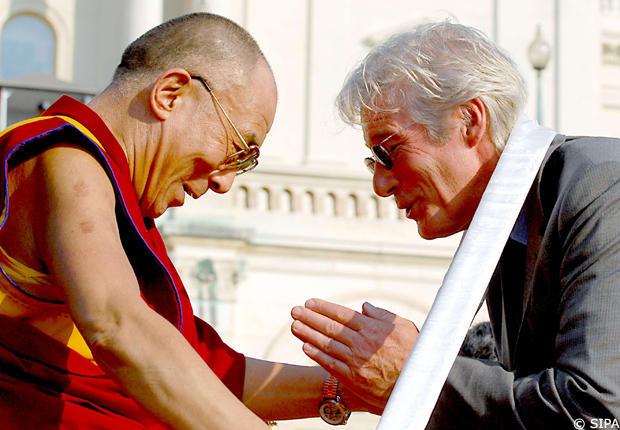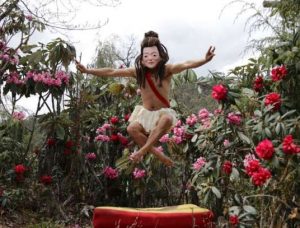Julia Roberts’s enigmatic smile is perhaps one of the best highlights of the film Pretty Woman. But for a lot of us, Richard Gere’s charm is what made the film worthwhile (even after watching the film about . . . six times. Maybe seven.) With his shy smile and gray-dusted hair, Gere stole the hearts of many women during the ‘90s, and continues to do so today. What to do? Pretty things walking down the street are always fun to look at.
Besides being one of Hollywood’s best-known stars, Richard Gere has been involved in Buddhism since reading about the Dharma and meeting a teacher. Now a popular celebrity Buddhist, he acts as a spokesperson for the Tibetan cause, and regularly donates to Buddhist undertakings.
Gere was born in Philadelphia on 31 August 1949. He was a philosophy major at the University of Massachusetts, but dropped out to pursue a career in acting. Performing on stage gave him a lot of experience, but his on-screen break came in 1977 in the film Looking Good for Mr. Goodbar. His rise to fame was unstoppable, and Gere has delivered box office hits such as An Officer and a Gentleman, American Gigolo,and my personal favorite, Hachi: A Dog’s Tale.
According to an interview with Libby Brooks of The Guardian in 2002, Gere converted to Buddhism in 1978, as a result of deep depression: “Suffering is very important. The worst kind is alienation suffering, which is probably true of most teenagers. I was habituated into seeing the universe in a certain way, then as I got older I realized it was not that way at all,” he admits. “That disconnection creates enormous tension.” Gere has been an avid student of both the Dalai Lama and Zen, and in an interview with Beliefnet.com, talks about his fascination with teachings on bodhichitta. He reveals that he does sitting meditation for at least an hour a day, although stresses that practice goes far beyond the cushion: “It’s all the teachings you’ve ever had,” he explains, “. . . mindfulness is a quality that’s always there. It’s an illusion that there’s a meditation and a post-meditation period . . . because you’re always mindful or you’re not . . . It’s always watching the mind.”
As stated in his biography, in 1987 Gere co-founded Tibet House, a not-for-profit organization in New York whose objective is to preserve Tibetan culture. His involvement in the Buddhist community is far-reaching. Gere has been the chairman of the board for the International Campaign for Tibet since 1995, and his organization, the Gere Foundation, provides relief assistance to places in need along with support for the Tibetan populace. In his foreword to the foundation’s website, he writes: “The goal of our programs is to establish a functioning framework of healthy spiritual and material values based on their own cultures and societies.” Gere has also sponsored visits of the Dalai Lama to New York City, in 1999, 2003, and 2007.
The international star’s commitment to worthy schemes extends even beyond Buddhism. Gere is an avid supporter of causes related to HIV/AIDS—he has worked with foundations in India, established the Gere Foundation India Trust in Delhi (in 1999), and started the Humanitarian Project in partnership with the Avahan AIDS Initiative (part of the Bill & Melinda Gates Foundation). The results of his humanitarian efforts can be seen worldwide.
In an interview published in Shambhala Sun, Richard Gere speaks with Melvin McLeod about his journey along the Buddhist path. Here is Gere’s response when asked whether he brings a Buddhist aspect to his films:
“In film, we’re playing with something that literally fragments reality, and being aware of the fragmentation of time and space I think lends itself to the practice, to loosening the mind. There is nothing real about film. Nothing. Even the light particles that project the film can’t be proven to exist. Nothing is there. We know that when we’re making it; we’re the magicians doing the trick. But even we get caught up in thinking that it is all real—that these emotions are real, that this object really exists, that the camera is picking up some reality.
On the other hand, there is some magical sense that the camera sees more than our eyes do. It sees into people in a way that we don’t normally. So there’s a vulnerability to being in front of the camera that one doesn’t have to endure in normal life. There’s a certain amount of pressure and stress in that. You are being seen, you are really being seen, and there is no place to hide.”
Richard Gere has touched many lives through his films and Buddhist activities. Journalist and author John Paul Flintoff has blogged about his experience interviewing Gere, and aptly titles the post “How Richard Gere Changed My Life.” Flintoff relates his thoughts as Gere talked about the nature of reality and Zen meditation. This prompted the journalist, curious as ever, to look into different Buddhist traditions, such as Zen, Pure Land, and Theravada. Flintoff describes how he has begun to accept the idea of reincarnation and to practice loving kindness. “When I tell people about this, they often ask if I’m a Buddhist. Since I’ve never joined anything—not even a meditation class—I’m not sure that I can be. But I’m a big fan of Thich Nhat Hanh, and very grateful to have met Richard Gere,” he concludes.
Richard Gere continues to be an international movie star, and a star spokesperson for many Buddhists around the globe, too.
See more
Interview with Richard Gere on Tibet (PBS.org)
BBC documentary on Richard Gere’s Buddhist beliefs















